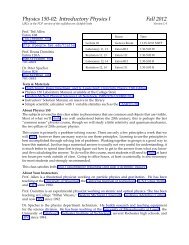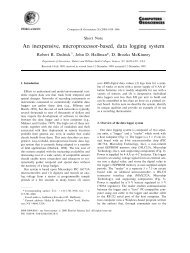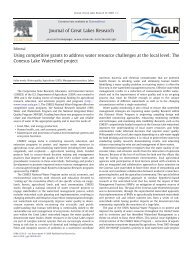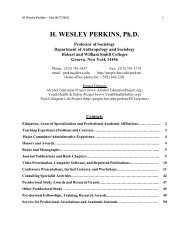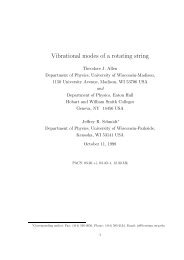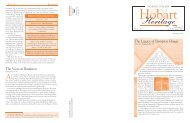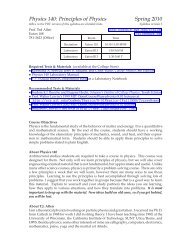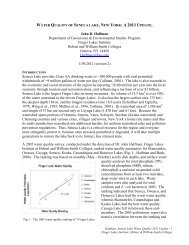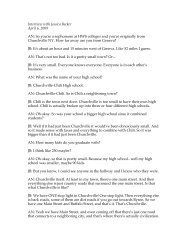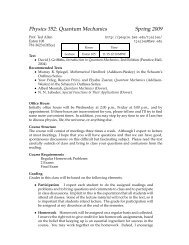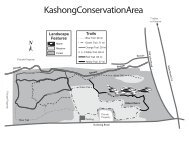Geology of New Zealand Field Trip Guidebook - ResearchGate
Geology of New Zealand Field Trip Guidebook - ResearchGate
Geology of New Zealand Field Trip Guidebook - ResearchGate
You also want an ePaper? Increase the reach of your titles
YUMPU automatically turns print PDFs into web optimized ePapers that Google loves.
Day 0—Thursday 13 November. Transit from Australia to Auckland, <strong>New</strong> <strong>Zealand</strong>. Store<br />
your extra luggage if you have any and catch your flight to Christchurch. If the weather is<br />
clear, you will have a spectacular overview (literally) <strong>of</strong> <strong>New</strong> <strong>Zealand</strong> geology on your flight.<br />
As you gain altitude out <strong>of</strong> Auckland, look back and notice the many small conical hills<br />
scattered throughout the city. These are all small volcanoes. Although none, except<br />
Rangitoto in the Auckland Harbor 1 , have erupted since humans arrived in <strong>New</strong> <strong>Zealand</strong> about<br />
800 years ago, they are still considered active. As you fly southeast, you’ll cross a relatively<br />
low and eroded landscape which was the setting <strong>of</strong> The Shire in Peter Jackson’s LOTR<br />
movies. Then you’ll cross the line <strong>of</strong> volcanoes and volcanic calderas that mark the surficial<br />
evidence <strong>of</strong> tectonic subduction far beneath the island. Note the contrast between the<br />
rounded and conical volcanic mountains <strong>of</strong> the North Island, and the jagged fault block<br />
mountains <strong>of</strong> the Southern Alps on the South Island.<br />
Southeast <strong>of</strong> Christchurch (Fig. 4) is the Banks Peninsula, which is composed <strong>of</strong> two<br />
extinct, overlapping and deeply-eroded basaltic volcanoes. The eastern <strong>of</strong> these is the Akaroa<br />
volcano, the western is called Lyttelton. Both are examples <strong>of</strong> hot-spot volcanoes erupting<br />
onto the interior <strong>of</strong> a plate (Sewall et al. 1992). Suggate (1978) describes them as “erosional<br />
calderas” in which wind and rain have breached the weak, innermost lava and tephra deposits<br />
that formerly composed the highest portions <strong>of</strong> the volcanoes, leaving large, bowl-shaped<br />
structures, perfect for the harbors <strong>of</strong> Akaroa and Lyttleton and echoing the process evidenced<br />
by the Tweed Volcano at Lamington National Park in Queensland. (These are very different<br />
from the felsic collapse or explosive calderas that we will see in the Taupo Volcanic Zone on<br />
the North Island.)<br />
As you approach Christchurch, you’ll pass over the Canterbury Plain, a broad eastdipping<br />
surface between the Banks Peninsula and the faulted and folded rocks <strong>of</strong> the<br />
Southern Alps. The area is intensively farmed and provided the locations for Rohan in<br />
LOTR. The landscape is underlain by Quaternary gravels deposited as coalescing<br />
sedimentary fans by braided streams carrying sediment eastward from the Southern Alps. In<br />
the last 2 Ma, the buildup <strong>of</strong> these deposits has shifted the eastern shoreline approximately 10<br />
km. Both erosion and transport were enhanced during glacial times, when glaciers extended<br />
down nearly to the western margin <strong>of</strong> the plains (Beanland 1987). In periglacial times, up to<br />
60 m <strong>of</strong> windblown loess was deposited on top <strong>of</strong> the gravels, significantly increasing the<br />
fertility <strong>of</strong> the area. With decreased sediment supply during the current interglacial, streams<br />
like the Wimakariri River, which flows through Christchurch, are now cutting into the gravel<br />
plain. If you get a good view <strong>of</strong> the plain from the air, you can imagine it being deposited as<br />
a blanket <strong>of</strong> clastic debris spreading out from the rising mountains to the west.<br />
You will have the evening free in Christchurch. You will be responsible for your<br />
own food and hostelry until you meet the group tomorrow morning. After this time,<br />
your housing, meals and transport will be covered until we return to Auckland after the<br />
conclusion <strong>of</strong> the program.<br />
[f\<br />
Day 1—Friday 14 November. We will rendezvous with the bus at 9 a.m. in Latimer Square,<br />
on the corner <strong>of</strong> Hereford and Latimer streets. Please be there on time. We will take a head<br />
count before we depart, but we will not wait for you if you are late. If you miss the bus, it<br />
1 Rangitoto was born about 800 years ago. There are several places where human footprints are preserved in<br />
the now-rock-hard volcanic ash. Therefore, we know the ancestors <strong>of</strong> the Maori had already arrived on the<br />
North Island and had gone out to explore the new piece <strong>of</strong> land that popped up in their midst. Today this little<br />
volcano is a park with some really wonderful hiking trails. If you plan to hang out in Auckland, it’s well worth<br />
a day trip.<br />
18




